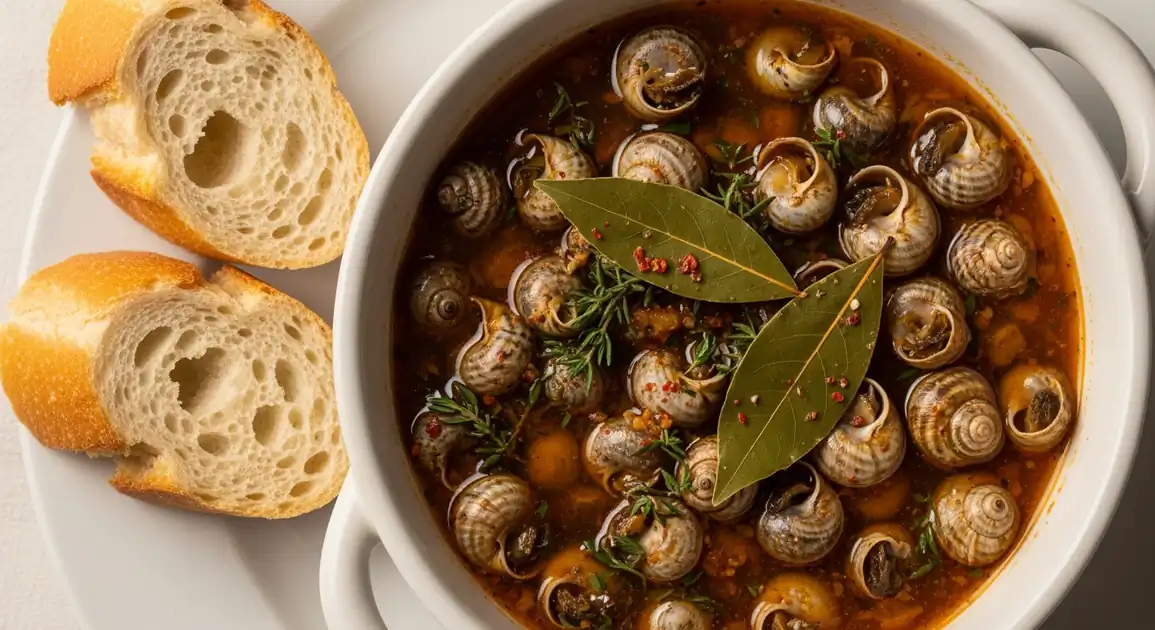Caracoles (Spanish Snails)
Caracoles

Description
Caracoles are enjoyed throughout Spain, but are most deeply embedded in the culinary traditions of southern regions, particularly Andalusia. While preparation methods vary slightly by region, the seasonal aspect remains consistent nationwide, with spring (April to June) being the traditional time to enjoy these delicacies. Beyond Seville, caracoles are popular in Madrid, Córdoba, and other Spanish cities, each with subtle regional variations in the seasoning and presentation.
Dietary Information
Serving information
Serving style
Typically served in a small ceramic cazuela (earthenware dish) with their cooking broth. Usually accompanied by bread for dipping in the sauce and small picks or toothpicks for extracting the meat from shells. Sometimes served with a separate empty dish for discarded shells.
Quick facts
Most caracoles vendors operate during standard Spanish dining hours: lunch (1 PM - 4 PM) and dinner (8 PM - 11 PM).
Safety Tips
What to Look For
-
Caracoles served piping hot in clean ceramic dishes
Properly heated caracoles ensure any potential harmful bacteria are eliminated. The traditional ceramic cazuela should be clean and the broth should be steaming.
-
Clear, aromatic broth with visible herbs and spices
Quality caracoles have a transparent, richly colored broth (often reddish-brown) with visible bay leaves, thyme sprigs, and other aromatics. Cloudy or murky broth may indicate poor preparation.
-
Busy establishments with high turnover during caracoles season
Popular places serving lots of caracoles likely prepare fresh batches daily, reducing the risk of serving old or improperly stored snails.
-
Visible kitchen practices or reputation for cleanliness
Establishments where you can observe preparation or that have a strong reputation among locals for cleanliness tend to maintain better food safety standards.
What to avoid
-
Caracoles served lukewarm or at room temperature
Properly cooked caracoles should always be served hot. Lukewarm serving indicates they may have been sitting out, increasing contamination risks.
-
Strong fishy or ammonia smell
Fresh, properly prepared caracoles should smell aromatic and herbaceous. Any strong fishy or ammonia odor indicates poor quality or spoilage.
-
Very cloudy, excessively thick, or oily broth
Good caracoles broth should be relatively clear though richly colored. Extreme cloudiness may indicate poor cleaning or preparation.
-
Shells that appear dirty or have residue
Clean shells indicate proper purging and washing. Dirty shells suggest inadequate preparation.
Price information
Price range
Budget tips
- A small portion (tapa) typically costs between 3-5 EUR, while a larger ración ranges from 8-12 EUR.
- Prices are often higher at the beginning of the season (late April) and lower as May progresses.
- Neighborhood bars away from tourist centers generally offer better value than those in main squares or tourist areas.
- Some bars offer free or discounted caracoles with purchase of drinks during specific hours (similar to traditional tapas culture).
Value indicators
- Generous portion size with plentiful broth.
- Accompanied by fresh bread at no extra charge.
- Served in traditional ceramic cazuela rather than disposable containers.
- Complex, aromatic broth rather than simple, under-seasoned liquid.
- Freshly cooked rather than reheated.
Where to Find This Dish
Traditional Neighborhoods
Authentic neighborhood bars throughout Spain serve seasonal caracoles, especially in areas less frequented by tourists.
Local plazas, Neighborhood markets
Afternoon, Evening
Market Areas
Food markets often have caracoles vendors during season, either for immediate consumption or take-away.
Municipal markets, Covered markets
Morning, Early Afternoon
Festival Grounds
During spring festivals, temporary food stalls often serve caracoles as a traditional seasonal offering.
Festival grounds, Temporary fair installations
Afternoon, Evening
Vendor Tips
- Look for 'Hay Caracoles' signs or chalkboards during spring months.
- Ask locals for recommendations - the best caracoles places aren't always the most obvious establishments.
- If a place offers caracoles year-round, be skeptical - authentic vendors only serve them in season.
How to Order
Regional Variations
-
Caracoles en Salsa (Basic Seville Style)
(Caracoles en Salsa)
The classic Sevillian preparation with a savory broth featuring cumin, bay leaf, garlic, and a hint of spice. This is the most common style found in spring throughout Seville.
-
Caracoles Picantes
(Caracoles Picantes)
A spicier variation with additional hot peppers (often guindilla) and more paprika, creating a more intensely flavored and spicy broth.
-
Caracoles con Hierbabuena
(Caracoles con Hierbabuena)
A variation that incorporates fresh mint (hierbabuena), giving the broth a refreshing, aromatic quality particularly popular in some parts of Andalusia.
-
Caracoles al Jerez
(Caracoles al Jerez)
Prepared with Sherry wine (from nearby Jerez), adding complexity and a slight sweetness to the broth. Often served in upscale restaurants.
-
Cabrillas
(Cabrillas)
A larger variety of land snail sometimes found alongside caracoles. They're typically prepared similarly but have different texture and slightly stronger flavor.
Cultural context
History
Caracoles have been consumed in Spain since ancient times, with archaeological evidence dating back to Roman settlements in Hispania. The preparation method evolved through centuries of Moorish influence in Andalusia, incorporating aromatic spices like cumin. Traditionally, caracoles were gathered in the wild after spring rains, when they had fed on aromatic herbs and were considered most flavorful. In Seville, caracoles became particularly associated with spring festivals and the April Fair (Feria de Abril), symbolizing the arrival of warmer weather and outdoor socializing.
Local significance
Caracoles symbolize the arrival of spring in Spanish culture. Their appearance in tapas bars marks the beginning of outdoor social season and is associated with festivals and gatherings.
Eating customs
- The proper way to eat involves either using a toothpick to extract the meat or, for smaller varieties, sucking them directly from the shell.
- It is customary and expected to use bread to soak up the remaining sauce, a practice called 'mojar el pan' that's considered essential to the experience.
- Caracoles pair traditionally with cold beer or dry sherry wine.